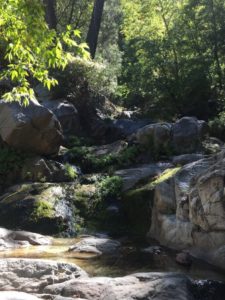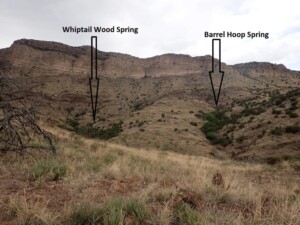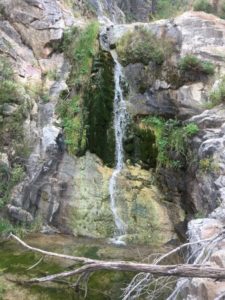What are springs?

A spring-fed stream in the Huachuca Mountains creates lush riparian habitat.
Springs are incredible places where water comes out of the ground and transforms the area around it into an oasis. In the Sky Islands, if you find water outside of a river or lake, there is a good chance you are at a spring. They can look like a pool of water surrounded by lush trees, a stream full of frogs that suddenly is flowing where before it was dry, a wet hillside covered in columbine, a marshy meadow with wildflowers, or a number of other forms. Springs create a cooler and wetter place for plants and animals to thrive. You can often tell you are near one when you see a clump of larger, greener vegetation that is different from the surrounding area.
How many springs are in the Sky Islands?
We know of about 2,500+ mapped springs in the U.S. portion of the Sky Islands. However, we still find unmapped springs regularly, so there are likely significantly more than that! In Mexico, springs aren’t as well mapped. We’ve surveyed about 50 springs in Mexico, with plans to map many more this year. Since about 60% of the Sky Island Region is in Mexico, we can expect that there are probably at least 4,500 springs in that area!
Where are springs?

Springs create dense patches of walnut and ash trees in the grasslands of the escarpment on Muleshoe Ranch Cooperatice Management Area in the southern end of the Galiuro Mountains.
There are more springs in rugged terrain because there are more opportunities for the ground surface to intersect the ground water table. As a result, there are a lot more springs in mountainous areas (about 75% of the springs in the Sky Islands are in the mountains). However, they can occur elsewhere. They tend to show up where there are faults and joints in the rocks, the rock type changes from one kind to another with different permeability to water, and near the major rivers and creeks that run along the bottom of large valleys.
In the mountains of the Sky Islands, springs are about half a mile apart, on average, while in the large river valleys, they are usually over a mile apart. It is not uncommon for springs in the valleys to be five miles or more from another spring.
What’s so great about springs?

A spring-fed stream in the Huachuca Mountains
Water, of course! While we have a few perennial (year-round) streams in the Sky Island region, most of our stream channels are dry unless it has rained recently. Springs are the primary water source for most wildlife in our region, and in many places, they are the main source of water for human uses, too. Many animals must travel to a spring every day to drink water. There are even many plants and animals that occur only at springs!
To learn even more about springs, explore the website of our partner, the Spring Stewardship Institute.
